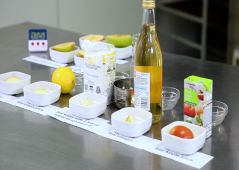Fats and Oils: Emulsion Experiments

An emulsion can be defined as a mixture of oily and watery liquids. To make an emulsion you need an emulsifier and force such as whisking and beating to break the oil droplets apart so they mix with the watery liquid.
There are two types of emulsions. The first is when water gets dispersed into fat/oil (such as butter, margarine or chocolate) and the second is when oil/fat gets dispersed in water (such as milk, mayonnaise, or salad dressing).
Emulsion Experiments
Characterising Emulsions
Emulsions are mixtures of immiscible materials such as oil and water. Such mixtures are possible by forming tiny droplets of one liquid (dispersed phase) and suspending them in the other liquid (continuous phase). In the case of foods, we normally encounter two types of emulsion – oil in water (o/w) in which the oil forms the dispersed phase and the water the continuous phase. The other type of emulsion commonly encountered with foods are water in oil emulsions (w/o). It is only possible to thin (dilute) an emulsion by addition of the continuous phase.
This experiment allows us to characterise emulsions by identifying the nature of the continuous phase
Materials
- 6 Watch glasses
- Milk, Cream, Butter ,Margarine, Mayonnaise, Low-calorie spread, Salad cream.
- A pepper shaker containing a mixture of Sudan III and methylene blue dyes (Sudan III is soluble in oil and methylene blue is soluble in water). WARNING these dyes are both poisonous and intensely coloured and if you get them on your fingers you will stain yourself! DO NOT eat the dyes or the foods onto which the dye have been added.
Method
- Place a small amount of each food in a separate watch glass
- Sprinkle a little of the dye mixture onto the surface of each food on a watch glass. Leave for a few minutes and then observe which dye has coloured the continuous phase. (with “solid” emulsions it may help if you warm them a little to help the continuous phase to melt)
- Note which foods are water-in-oil emulsions and which are oil-in-water emulsions.
Questions
1. Why does the low-calorie spread have a lower energy value than margarine?
2. What happens to the emulsion when cream is churned into butter?
Forming Emulsions
The process of forming an emulsion can be assisted by the addition of surface active “emulsifying” agents.
This experiment investigates which common food materials have emulsifying properties (and which do not).
Materials
- One Test tube rack
- 10 Test tubes
- Three spatulas
- Three five ml Measuring cylinders
- Oil, Vinegar, an Egg (separated into white and yolk), Mustard, Salt, Pepper, Sugar, Paprika, Glyceryl Monostearate – GMS
Method
Measure 5ml of vinegar into each of a series of 10 test tubes in a rack. Add the various ingredients as indicated below and shake each tube 100 times.
Observe the contents of each tube immediately after shaking and again after they have been left standing in the rack for 10 minutes.
| Tube no | Oil | Vinegar | Other additions |
|---|---|---|---|
| 1 | 5ml | 5ml | |
| 2 | 10ml | 5ml | |
| 3 | 5ml | 5ml | 1g mustard |
| 4 | 5ml | 5ml | a pinch of salt |
| 5 | 5ml | 5ml | a pinch of pepper |
| 6 | 5ml | 5ml | a pinch of sugar |
| 7 | 5ml | 5ml | 1ml of egg yolk |
| 8 | 5ml | 5ml | 1ml of egg white |
| 9 | 5ml | 5ml | a pinch of paprika |
| 10 | 5ml | 5ml | a pinch of glyceryl monostearate |
Questions
Which tubes contain temporary emulsions?
Which tubes contain permanent emulsions?
Which of the substances used exerts an emulsifying influence?
Which of the substances produces a 'thicker' emulsion?
Making a reduced cost cake
The most expensive ingredients in many conventional cakes are the shortening materials (butter or margarine). If we can reduce the amount of such ingredients without diminishing their performance, then we can reduce the overall product cost. Butter and margarine are both water in oil emulsions (mixtures of tiny drops of water suspended in a continuous phase of oil).
By understanding the science that underlies emulsions we can add alternative emulsifying agents which undertake the same function as the conventional ingredients but at a fraction of the cost. Several emulsifying agents are available, but in this experiment we will use Glycerol Monostearate.
Suggested formulation
Cake flour 78g
Baking powder 2.9g
Salt 1.5g
Vanilla 1.2ml
Milk 79ml
Margarine 33g
Glycerol Monostearate 8g
Sugar 100g
Egg 36g
Method
1. Sieve flour, GMS, salt and baking powder together
2. Cream fat and sugar
3. Add whisked egg, vanilla essence and milk
4. Gradually add flour mix
5. Place in a greased lined cake tin (approx 19 x 9 x 5 cm). Bake at 190°C for about 30 mins.


